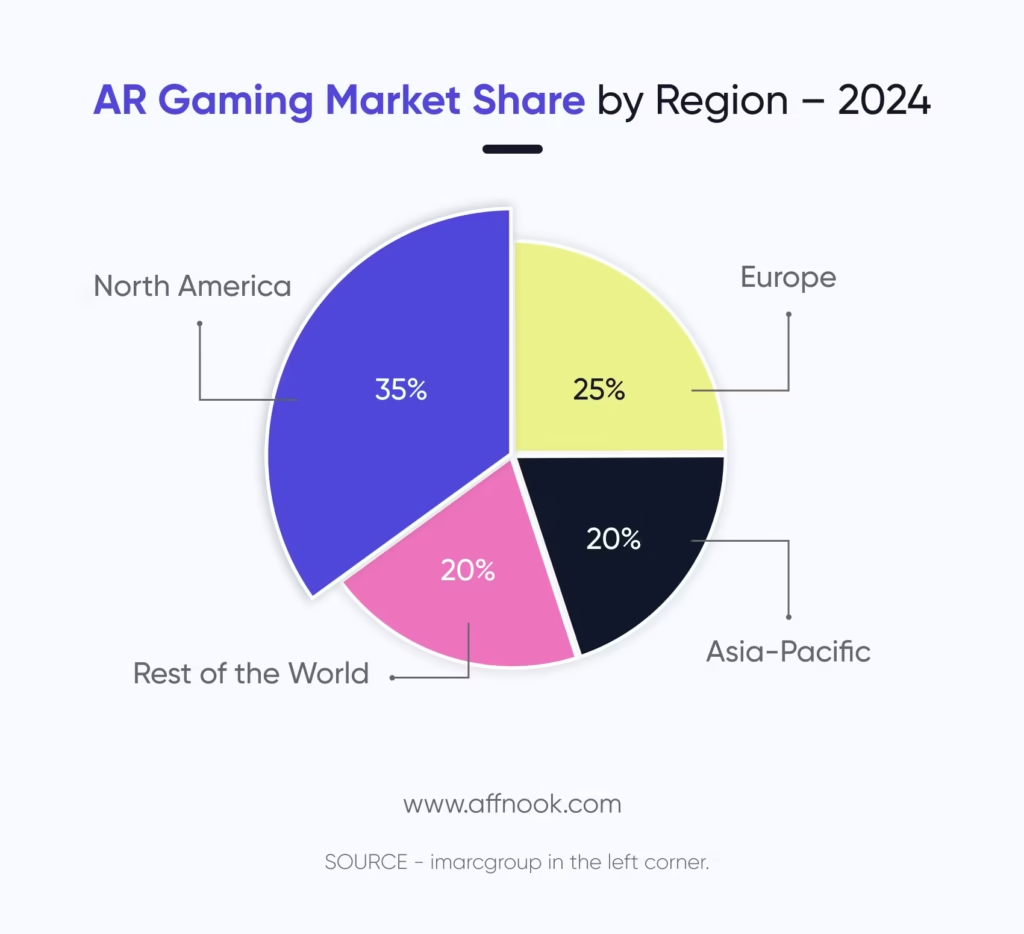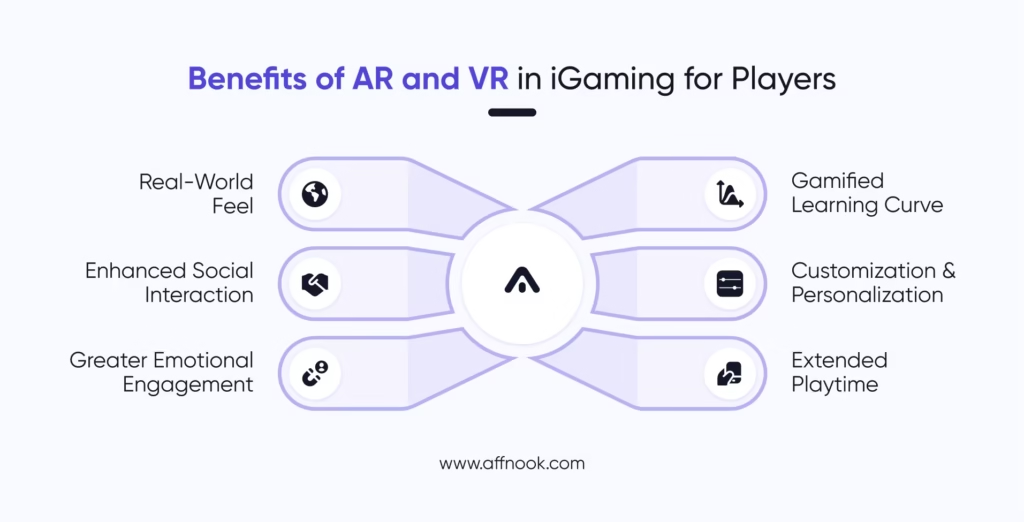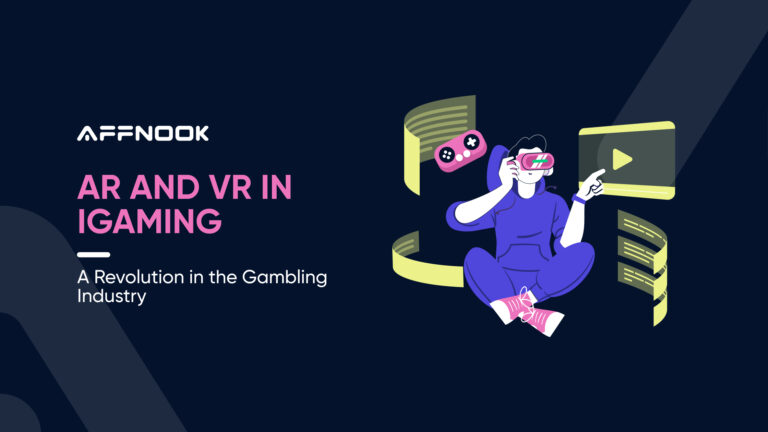Imagine putting on a headset and suddenly finding yourself inside a buzzing casino, surrounded by players and live action, all while sitting on your couch. That’s the magic of augmented reality and virtual reality in iGaming, turning online play into a thrilling, real-world adventure
The iGaming industry is always ready to adopt new technologies to enhance player experiences, but AR and VR are quickly changing the whole scenario in the industry.
Instead of playing on a flat 2D screen, AR and VR have created an immersive world that gives you the real feel of games. This technology advancement not only helps brands to improve the player experience but also helps to attract and engage more players.
Due to technological advancements, the global AR gaming market is projected to reach $14.2 billion in 2024 and is expected to grow to $141.7 billion by 2033.
In this blog, you will learn more about augmented reality and virtual reality in iGaming and how they enhance the player experience, and key benefits brands can take from this technology.

Understanding the Concept of AR and VR in iGaming
Augmented reality and virtual reality are changing the way people play games in the iGaming industry. They make online gaming more fun, exciting, and realistic so that players can have more fun while playing from their comfortable place at home.
What is Augmented Reality?
Augmented reality (AR) is a technology that adds digital images, sounds, and information on top of what you are using in real life, like a mobile, tablet, or AR glasses. In the iGaming industry, AR makes online gambling more fun by mixing the game features with your actual surroundings.
So, stop playing on a normal screen and take advantage of AR and reform your ordinary table into a virtual poker table, spin a slot machine on your kitchen counter, and see live stats of your favorite game in your living room.
How does AR work in iGaming?
This technology uses your camera, GPS, sensors, and your internet connection to detect your surroundings and place a digital object into them. Here is the breakdown of how they typically work:
- Device Detection: First, the AR application or games scan your nearby areas with the help of your camera and sensor to create an interactive environment.
- Augmented View: Once it scans the surface and location of a player, the game places 3D objects like cards, chips, or slot machines onto it.
- User Interaction: You can interact with the game by touching your mobile screen or moving your device in any direction.
For example, if you open an AR casino application, it can place a roulette wheel on your table. It starts when you tap on the screen. It makes your game feel real and interactive.
Types of AR Technology Used in iGaming
Augmented reality adds a digital layer to the real world. In the iGaming industry, different types of AR technology help to create more fun and interactive gambling experiences.
1. Marker-based AR:
This type of AR technology is used as a visual marker, like a QR code. When you scan that QR with your device, it shows the 3D game object or animation on the screen.
2. Markereless AR (Location-based AR):
This is also known as location-based AR This technology uses your device location, compass, and motion sensors to place digital elements based on your location.
3. Projection-based AR
This technology uses light to show the digital image on real-world surfaces. Though it’s mostly used in physical setups like gaming events or casinos, it has potential for creating interactive AR environments.
4. Augmented View AR
This technology replaces parts of the real world with digital visuals. It enhances your view by adding, removing, or changing real-world objects in real time.
Augmented reality and virtual reality in iGaming go beyond being simple tech trends. They’re reshaping how we think about online gambling. By making games more immersive, interactive, and enjoyable, these technologies can transform your living room into a vibrant casino lounge, offering a whole new level of excitement.
What is Virtual Reality?
Virtual reality is a technology that helps to create a fully digital 3D environment where users can move around and interact with virtual objects. VR is used to build life-like casino environments and betting experiences that feel just like the real thing without ever leaving your home.
How Does VR Work in iGaming
To enjoy VR gaming, players usually wear a VR headset. These headsets block the real world and show you an immersive virtual space. With added tools like hand controllers or motion sensors, players can:
- Walk around a virtual casino.
- Sit at a poker table with another player.
- Pull a slot machine lever with hand gestures.
- Watch live sports in a 360-degree virtual stadium.
Types of VR Technology Used in Gaming
Virtual reality comes in different forms, depending on the device you are using and how immersive your experience is. In iGaming, these VR types are helping create new ways to play and enjoy games.
1. Fully immersive VR:
This is the most advanced type of VR technology. It uses advanced devices like VR headsets, motion sensors, and hand controllers to fully place the player inside a virtual world.
2. Semi-Immersive VR
This setup offers a mix of virtual experience and real-world awareness. It usually involves large screens, 3D graphics, and sometimes VR goggles, but without full isolation from your surroundings.
3. Non-Immersive VR
This is the common basic type of VR. It doesn’t use a headset, it is just a screen ( computer or mobile) to display a virtual 3D world.
Real-World Examples of AR and VR in iGaming
Most Popular AR Games
Augmented reality (AR) has introduced a new and fun way to play games by mixing the real world with digital elements. While AR in iGaming is still developing, many AR games from different categories have already become very popular. These games show how AR can make gaming more exciting, realistic, and interactive.
Pokémon GO
One of the most famous AR games ever, Pokémon GO lets players catch virtual Pokémon in real-world locations using their smartphones. It uses GPS and camera features to place game characters in your surroundings.
Why it’s popular: It combines gaming with real-world exploration and encourages players to get outdoors.
Ingress Prime
Made by the same developers as Pokémon GO, Ingress Prime is a sci-fi AR game where players choose a side and battle for control of real-world landmarks by capturing portals.
Why it’s popular: It turns real cities into battlegrounds, giving players a unique mission-based gaming experience.
Jurassic World Alive
It is a dinosaur game in which players have to collect DNA samples of dinosaurs that appear in their real surroundings. You can create your own dinosaur team and battle with others.
Why it’s popular: It brings dinosaurs to life in your neighborhood, which is thrilling for fans of the franchise.
Gonzo’s Treasure Hunt AR
This innovative live game show combines elements of slots and live casino gameplay, featuring a 3D treasure hunt experience set in the mythical city of El Dorado. Players can engage in the hunt using AR technology, enhancing the immersive experience.
Monopoly Live
An AR-infused version of the classic board game, Monopoly Live, combines a live dealer with a 3D virtual board, where players can participate in a game show-like experience, enhancing the traditional Monopoly gameplay with interactive features.
Most Popular VR Games
Virtual reality has offered a wide range of games that offer a fun, realistic, and fully immersive experience. While not all games are related to iGaming, they show how technological advancements can change the gaming experience. Here are some of the most popular VR games that players prefer:
PokerStars VR
Pokerstars VR game is one of the best examples of a realistic game, It allows you to play poker in a virtual casino that looks real. It also allows players to interact with each other, use hand gestures, and even throw chips just like a real game.
Beat Saber
This is a music and rhythm game where players slash colored blocks to the beat of energetic songs. It is fun, physical, and one of the top-selling VR games worldwide.
VR Chat
This is more of a social experience than a game, where players can meet others, create their own avatars, and explore virtual worlds together. It’s a great example of collaborative VR.
VR Roulette
One of the pioneering VR casino games, VR Roulette offers players a live, immersive roulette experience where they can interact with the game and other players in
Key Differences Between AR and VR in iGaming

How AR and VR Technology Enhance the Player Experience
Online gambling is no longer limited to flat screens or simple taps. Now players can step into a 3D casino, or they can sit at a virtual poker table. AR and VR have totally changed the gameplay experience for players.
Let’s learn more about how these technologies are enhancing the player experience.
1. More Realistic Gameplay
VR transports players into a fully simulated 3D environment where players can walk around in the casino lobby, they can end up in different rooms, or sit at a poker table. They can also use hand gestures to interact with other players. This real-life feel setup makes the user feel like they are present physically in a real casino.
2. Interactive Environment
With the help of AR technology, players can merge digital games with their physical environment. By using smartphones, tablets, or AR glasses, they can project a roulette table on their desk. This combination of real and digital worlds makes gambling more accessible, exciting, and fun. So you can make any space into a gaming zone
3. Better Social Interaction
Both augmented reality and virtual reality give multiplayer features where players can interact with each other in real time using voice chat, avatars, and with their body language. In VR casinos, you can see other players’ actions, read their gestures, and communicate naturally. This creates a social atmosphere similar to traditional casinos, making online gambling more engaging.
4. Immersive Sports Betting
With AR, you can view live sports stats right in your room or place bets on a virtual scoreboard. VR lets you sit in a 3D stadium and follow the game action closely while betting.
5. Increased Trust and Engagement
When the gaming experience feels more real and open, players are more likely to trust the platform and stay longer. This boosts engagement and creates loyal users.

How AR and VR in iGaming Keep Games Safe and Fair
AR and VR technologies are becoming more common in the iGaming industry. But maintaining security and providing fair gameplay is a key responsibility for brands and iGaming operators. These advanced technologies make gaming more fun and realistic, but they also bring new risks that need to be carefully managed.
1. Data Privacy & Security
AR and VR games often collect personal data like:
- Location
- Device usage
- Eye tracking and hand movement (in VR)
- Voice and camera inputs
Why data security matters: As we know, the workings of these technologies are based on our personal data, and hacking or data breaches are a main concern in the iGaming industry. So, iGaming platforms must use encryption, secure logins, and privacy policies to protect user data.
2. Fair Gameplay
Traditional online casinos use Random Number Generators (RNGs) to ensure fairness. In AR and VR gaming, the experience is more visual and interactive, but fairness must still be ensured through:
- Certified and transparent algorithms
- Anti-cheat systems
- Real-time monitoring of suspicious behavior
Why it matters: As players can interact more freely in AR and VR spaces, there’s a higher risk of manipulation. Developers must make sure the game rules and outcomes can’t be tampered with.
3. Identity & Player Verification
In AR and VR casinos, users often create avatars. Platforms need to make sure:
- These avatars represent real verified users
- Age restrictions and KYC (Know Your Customer) processes are in place.
- There’s no room for fake or duplicate accounts
4. Preventing Harassment and Abuse
Virtual spaces sometimes open the door to verbal or physical (virtual) harassment. iGaming platforms should:
- Include reporting tools
- Offer safe zones or mute/block features for users
Challenges and Limitations of AR and VR in iGaming
1. High Cost of Devices
To play AR and VR games, players need special equipment like AR glasses, VR headsets, and motion controllers. These devices are very costly, so it is not possible for everyone can buy these devices or try these games.
2. Limited Availability
Not everyone has access to AR or VR-compatible devices. Also, not all iGaming platforms support this technology yet, which limits how many players can enjoy these games.
3. Advanced Technical Requirements
If you want a unique gaming experience, you have to carry a powerful device that has a better battery life and strong network connectivity for smooth gameplay without any lag.
4. Health Risks
Some players feel dizzy, tired, or even sick after using VR for a while. Long sessions wearing headsets can also cause headaches or eye strain, especially for new users.
5. Slow Adoption
Many online casinos and betting platforms are still experimenting with AR and VR technology. Developing high-quality, immersive games takes time, money, and experienced developers. Due to this, the rollout of these features is slow.
Conclusion
Augmented reality and virtual reality in iGaming are no longer just cool tech terms, they are changing how people experience online gambling. Instead of just tapping on a flat screen, players can now feel like they are inside a real casino or watching live sports in a 3D stadium from their homes.
You can place a virtual poker table on your own desk, spin a slot machine in your kitchen, or even chat with other players at a virtual table. These technologies make the gaming experience more fun, real, and exciting.
As this technology is still being tested and improved, but in the future it will become more affordable and reliable, more online casinos are likely to adopt it. For anyone in the iGaming industry, understanding AR and VR early can give you a head start.




